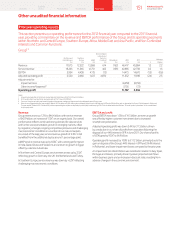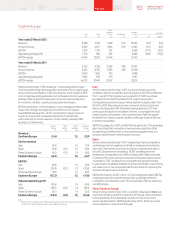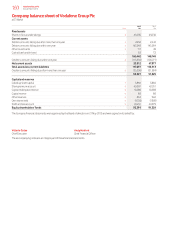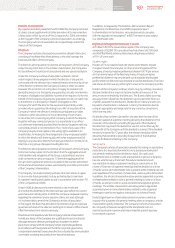Vodafone 2013 Annual Report Download - page 163
Download and view the complete annual report
Please find page 163 of the 2013 Vodafone annual report below. You can navigate through the pages in the report by either clicking on the pages listed below, or by using the keyword search tool below to find specific information within the annual report.
1. Basis of preparation
The separate nancial statements of the Company are drawn up in accordance with the Companies Act 2006 and UK GAAP.
The preparation of Company nancial statements in conformity with generally accepted accounting principles requires management to make
estimates and assumptions that affect the reported amounts of assets and liabilities and disclosure of contingent assets and liabilities at the
date of the Company nancial statements and the reported amounts of revenue and expenses during the reporting period. Actual results could
differ from those estimates. The estimates and underlying assumptions are reviewed on an ongoing basis. Revisions to accounting estimates are
recognised in the period in which the estimate is revised if the revision affects only that period or in the period of the revision and future periods if the
revision affects both current and future periods.
As permitted by section 408(3) of the Companies Act 2006, the prot and loss account of the Company is not presented in this annual report.
Theseseparate nancial statements are not intended to give a true and fair view of the prot or loss or cash ows of the Company. The Company
hasnot published its individual cash ow statement as its liquidity, solvency and nancial adaptability are dependent on the Group rather than its
own cash ows.
The Company has taken advantage of the exemption contained in FRS 8 “Related Party Disclosures” and has not reported transactions with fellow
Group undertakings.
The Company has taken advantage of the exemption contained in FRS 29 “Financial Instruments: Disclosures” and has not produced any
disclosuresrequired by that standard, as disclosures that comply with FRS 29 are available in the Vodafone Group Plc annual report for the
yearended 31 March 2013.
2. Signicant accounting policies
The Company’s signicant accounting policies are described below.
Accounting convention
The Company nancial statements are prepared under the historical cost convention and in accordance with applicable accounting standards of the
UK Accounting Standards Board and pronouncements of the Urgent Issues Task Force.
Investments
Shares in Group undertakings are stated at cost less any provision for impairment.
The Company assesses investments for impairment whenever events or changes in circumstances indicate that the carrying value of an investment
may not be recoverable. If any such indication of impairment exists, the Company makes an estimate of the recoverable amount. If the recoverable
amount of the cash-generating unit is less than the value of the investment, the investment is considered to be impaired and is written down to its
recoverable amount. An impairment loss is recognised immediately in the prot and loss account.
For available-for-sale investments, gains and losses arising from changes in fair value are recognised directly in equity, until the investment
is disposed of or is determined to be impaired, at which time the cumulative gain or loss previously recognised in equity, determined using the
weighted average cost method, is included in the net prot or loss for the period.
Foreign currencies
Transactions in foreign currencies are initially recorded at the rates of exchange prevailing on the dates of the transactions. Monetary assets and
liabilities denominated in foreign currencies are retranslated into the Company’s functional currency at the rates prevailing on the balance sheet
date. Non-monetary items carried at fair value that are denominated in foreign currencies are retranslated at the rates prevailing on the initial
transaction dates. Non-monetary items measured in terms of historical cost in a foreign currency are not retranslated.
Exchange differences arising on the settlement of monetary items, and on the retranslation of monetary items, are included in the prot and loss
account for the period. Exchange differences arising on the retranslation of non-monetary items carried at fair value are included in the prot and
loss account for the period.
Borrowing costs
All borrowing costs are recognised in the prot and loss account in the period in which they are incurred.
Taxation
Current tax, including UK corporation tax and foreign tax, is provided at amounts expected to be paid (or recovered) using the tax rates and laws that
have been enacted or substantively enacted by the balance sheet date.
Deferred tax is provided in full on timing differences that exist at the balance sheet date and that result in an obligation to pay more tax, or a right
to pay less tax in the future. The deferred tax is measured at the rate expected to apply in the periods in which the timing differences are expected
to reverse, based on the tax rates and laws that are enacted or substantively enacted at the balance sheet date. Timing differences arise from the
inclusion of items of income and expenditure in taxation computations in periods different from those in which they are included in the Company
nancial statements. Deferred tax assets are recognised to the extent that it is regarded as more likely than not that they will be recovered.
Deferredtax assets and liabilities are not discounted.
Notes to the Company nancial statements
161 Vodafone Group Plc
Annual Report 2013
Overview Business
review Performance Governance Financials Additional
information
























